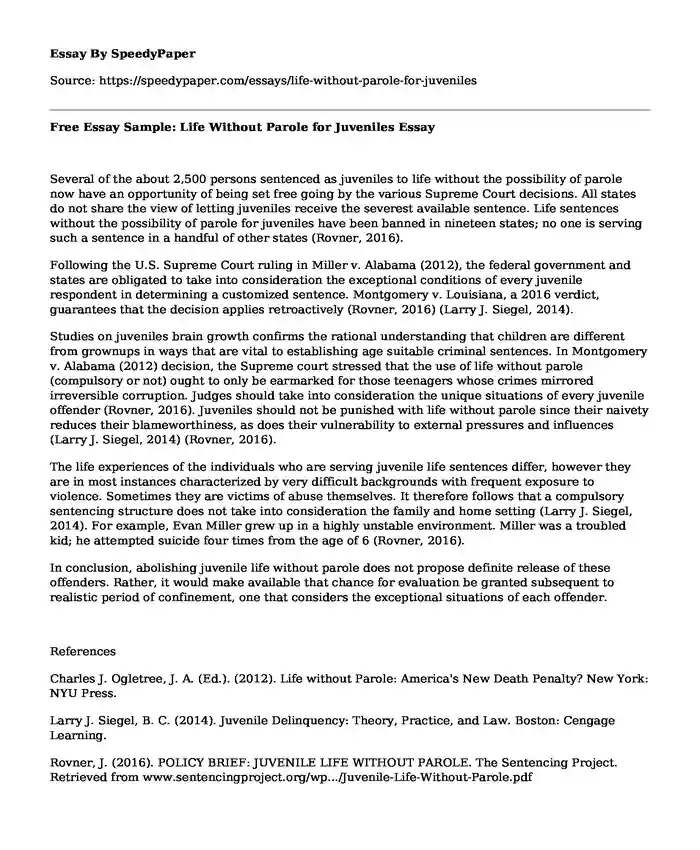
| Type of paper: | Essay |
| Categories: | Law Court system Punishment Juvenile justice |
| Pages: | 2 |
| Wordcount: | 399 words |
Several of the about 2,500 persons sentenced as juveniles to life without the possibility of parole now have an opportunity of being set free going by the various Supreme Court decisions. All states do not share the view of letting juveniles receive the severest available sentence. Life sentences without the possibility of parole for juveniles have been banned in nineteen states; no one is serving such a sentence in a handful of other states (Rovner, 2016).
Following the U.S. Supreme Court ruling in Miller v. Alabama (2012), the federal government and states are obligated to take into consideration the exceptional conditions of every juvenile respondent in determining a customized sentence. Montgomery v. Louisiana, a 2016 verdict, guarantees that the decision applies retroactively (Rovner, 2016) (Larry J. Siegel, 2014).
Studies on juveniles brain growth confirms the rational understanding that children are different from grownups in ways that are vital to establishing age suitable criminal sentences. In Montgomery v. Alabama (2012) decision, the Supreme court stressed that the use of life without parole (compulsory or not) ought to only be earmarked for those teenagers whose crimes mirrored irreversible corruption. Judges should take into consideration the unique situations of every juvenile offender (Rovner, 2016). Juveniles should not be punished with life without parole since their naivety reduces their blameworthiness, as does their vulnerability to external pressures and influences (Larry J. Siegel, 2014) (Rovner, 2016).
The life experiences of the individuals who are serving juvenile life sentences differ, however they are in most instances characterized by very difficult backgrounds with frequent exposure to violence. Sometimes they are victims of abuse themselves. It therefore follows that a compulsory sentencing structure does not take into consideration the family and home setting (Larry J. Siegel, 2014). For example, Evan Miller grew up in a highly unstable environment. Miller was a troubled kid; he attempted suicide four times from the age of 6 (Rovner, 2016).
In conclusion, abolishing juvenile life without parole does not propose definite release of these offenders. Rather, it would make available that chance for evaluation be granted subsequent to realistic period of confinement, one that considers the exceptional situations of each offender.
References
Charles J. Ogletree, J. A. (Ed.). (2012). Life without Parole: America's New Death Penalty? New York: NYU Press.
Larry J. Siegel, B. C. (2014). Juvenile Delinquency: Theory, Practice, and Law. Boston: Cengage Learning.
Rovner, J. (2016). POLICY BRIEF: JUVENILE LIFE WITHOUT PAROLE. The Sentencing Project. Retrieved from www.sentencingproject.org/wp.../Juvenile-Life-Without-Parole.pdf
Cite this page
Free Essay Sample: Life Without Parole for Juveniles. (2019, Oct 15). Retrieved from https://speedypaper.net/essays/life-without-parole-for-juveniles
Request Removal
If you are the original author of this essay and no longer wish to have it published on the SpeedyPaper website, please click below to request its removal:
- Free Essay on the Paperless Debate
- Linguistics Essay Example: Language and Variation
- Free Essay Comprising the Full Script Analysis of Cloud 9 by Carl Churchill
- Essay Sample: E-Commerce Is the Future of Business Transactions
- Free Essay Dedicated to The Hunger Games: Societal Inequality
- Paper Example: Indigenous Women in Mexico
- What is realism? Essay Example
Popular categories




